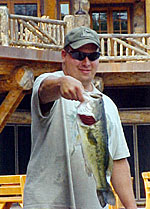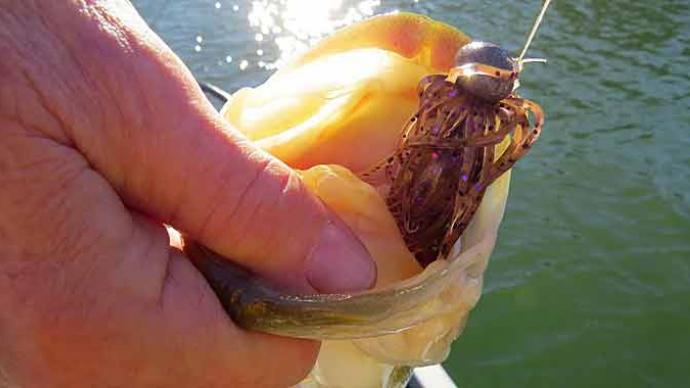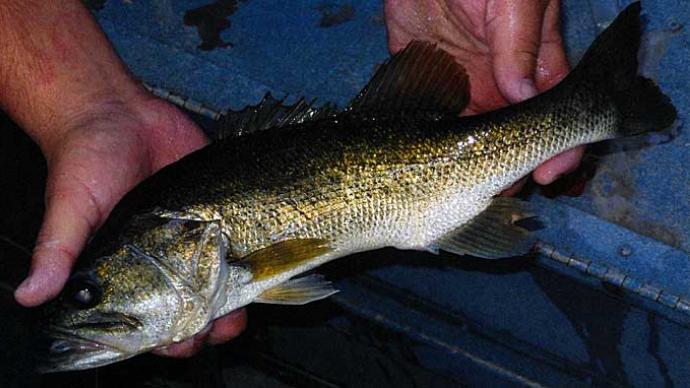
Despite what my loving wife says...I am not talking about myself... . No, I am talking about fish here, specifically older fish which have seen better days. We have all seen it in our own ponds, a fish in decline. The telltale signs are a long, thin creature with giant head disproportionately large compared to the rest of its body. The head looks almost cartoonish, like it should be on a bass body twice the size of the one on which it resides. This fish is probably quite old and, just a few years or even months ago, had a much more robust body.
A once-majestic fish that probably ruled the roost in its prime is now on its last downhill slide.
It's a little sad really.
Why does this happen?
Most freshwater fish have an indeterminate growth rate...which means they can continue to grow their entire lives if there are enough resources, primarily food. In order for a bass (or any fish) to grow large, it needs good water quality, food and time to grow. How much food? Well, in a naturally managed pond, a lot of it! Most biologists argue that it takes ten pounds of food for every pound of growth. In most food chains, about 90% of the energy (and biomass) is lost to the environment; therefore it is not transferred to the next feeding level. Where does all this biomass and energy go? Some is lost to heat, some energy is lost to movement and body functions and some is not used by the predator and is excreted (like the bones of a baitfish). Generally speaking, fish also grow slower as they get older, compounding the problem.
Another factor in that equation is that food for a predator, specifically other fish, is made mostly of water. If we could wring out a bluegill, as much as 80% of that fish is water. That means ten pounds of baitfish are really two pounds of nutrition, once the water is extracted by the one which dines.

Competition for food resources can be tough in most unmanaged (and many managed) ponds. It seems the most intense competition for food resources occurs when bass are intermediate in size. You've seen it. Most ponds have too many bass from 10- 14 inches and those bass consume much of the food resources in the pond, well before young baitfish can grow into sizes which would be more substantial to the rest of the adult population. That is why this magazine (and the majority of fisheries biologists) has lauded the benefits of culling this group of largemouth bass.. .to free up food resources to make big fish bigger and to keep really big fish from going into decline.
You have permission to eat some of your predator fish. Go ahead, fillet some of the mid¬sized predators, roll in your favorite cornmeal mixture and fry at 350° until golden brown.
The biggest bass in the pond are probably a little slower than they once were and they cannot quite beat out the 14 inch bass when they go after those 3-4 inch baitfish snacks. Besides, bigger bass depend on bigger meals and they aren't really interested in chasing little baitfish. When a mature bass can no longer chase down forage at the same rate as younger fish it begins to face decline.. .unless it can eat those younger bass. It's part of the process. Besides, when large bass grow old. their senses decline and they reach their own geriatric times. The number of baitfish that these old brutes encounter typically drops and they begin to lose body mass, but their head and length does not shrink with them. The large fish that I have seen in this state also appear to be more susceptible to other stresses in the pond that are minor problems with younger, well fed, more robust fish. Parasite loads, fraying of fins (note the tail of the bass I am holding in the picture), fraying of gills, lethargy and other outward signs of disease are more evident. I have held many lake trout, pickerel, pike and largemouth bass that have been in this condition. If the decline continues, this might be the last year of life for this fish.

A combination of factors normally leads to the decline of a fish. Declining food chain, advancing age, decline of sensory perception, parasites and physical anomalies combine to ultimately cause the demise of that fish.
What to do?
Feed your fish before they get into this condition.. .that's what! Monitor the game fish in your pond to make sure they are well fed. If it's bass we are talking about...their bellies should be convex and bulging, not concave and skinny. If you see skinny bass, oftentimes there is not enough food for them. They could be starving! Look at your fish population as a whole. If substantial numbers of fish are declining, you likely have a food chain issue. If it's a few fish, there may be other issues. Several years ago. Pond Boss published a story about a declining bass whose stomach was loaded with soft plastic baits and its digestive system was blocked. Other fish in that population were thriving, fat creatures definitely on the rise to stardom.
If your bass population has numbers of declining fish, cull bass in intermediate sizes... if your goal is to increase sizes. Culling these fish will free up valuable baitfish that will hopefully be utilized by larger, more desirable game fish for better growth rates. This strategy could be one tool to avoid decline and loss of weight as geriatric bass grow older and slower.
Another solution is to make sure your bass get the nutrition they need by stocking some high protein forage that they can catch easily. The largest bass in your pond may benefit greatly from 8-10" trout! Last summer I surveyed a private lake in Pennsylvania that has been stocking thousands of rainbow trout for the last 60 consecutive years. The pond is deep enough to hold trout, but after some investigation, the bottom water loses all oxygen in the summer. The electrofishing and gill netting survey yielded zero trout. That's right...none. But, the survey turned up some of the largest bass that I have ever seen in the northeast. Many bass over 5 pounds and 6-7 pound bass were common. Was this lake particularly productive? No, in fact the water chemistry indicated the lake was nutrient poor, with low alkalinity, low hardness, low total dissolved solids, low phosphorus and low nitrogen. I think most of those trout were bass food. Most stocked fish are dumb and are lethargic themselves. They don't have a natural fear of predation and tend to hang around the shallows and near feeders. This is the perfect food for that slow giant that you want to flop a steak to. One of the first times I met Bob Lusk he was feeding my precious, hand-fed trout to trophy largemouth bass and pike. I was not happy about this at the time... but in retrospect it was the right thing to do... the bigheaded bass in the picture is one from that same lake. That fish needed a Big Mac... fast. Feeding trout to bass and other game fish is not new, but it is expensive.. .decide if your fish are worth it and do it in the spring or fall when the trout have a chance to live for a few weeks or months to be properly consumed and get the most bang for your buck.

Another favorite tactic is to feed those fish a commercially available diet. If you start by growing feed-trained fish in your pond or lake, you will probably avoid the big head, small bodied oldster hobbling around your pond. Even if you cannot get the big predators on feed themselves, you should be able to get what they eat in the pond on feed. Bluegill are exceptionally easy to convert to feed. By feeding the forage fish, you will indirectly feed the predator. Big predator fish will lurk in the shadows off the feeders and wait to ambush prey. You may want to consider adding some structure for predator cover somewhere adjacent to the feeders. Feeding forage fish will also make those baitfish healthier, increasing their fitness and reproductive health, adding value to the whole system.
It's a shame to see a big fish in decline. It took a lot for you and your pond to produce that big fish, so try to keep it big and in top condition by doing a few things that make good sense for your pond anyway. Free up a few pond resources and keep that oldster fat and happy.
Mark Cornwell is a fisheries professor at SUNY-Cobleskill in Cobleskill, New York. His passion is raising walleye and the I.Q. of fisheries students in the Northeast. Reach him at CORNWEMD@Cobleskill.edu.
Reprinted with permission from Pond Boss Magazine



